Global autonomous car market is estimated to be valued at US$ 205.98 Bn in 2025 and is expected to reach US$ 2,205.13 Bn by 2032, exhibiting a compound annual growth rate (CAGR) of 40.3% from 2025 to 2032.
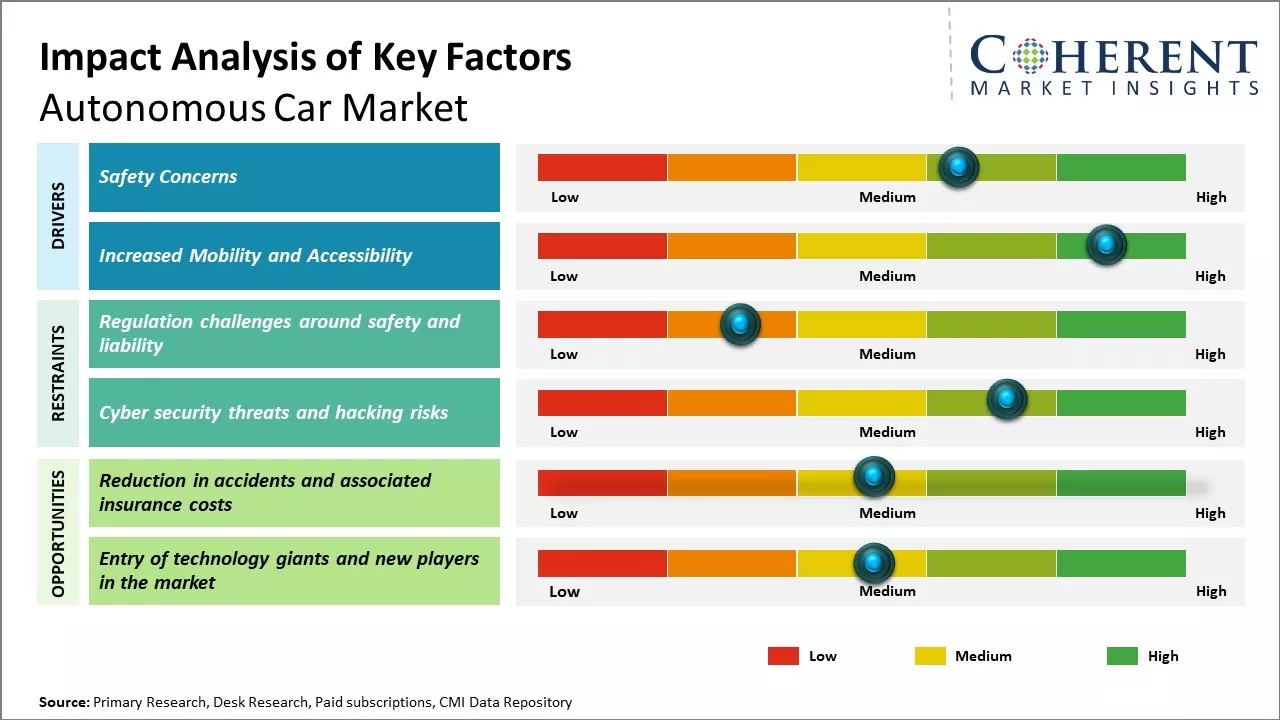
Discover market dynamics shaping the industry: Request sample copy
Global autonomous car market is expected to witness significant growth in the near future. By 2032, it is estimated that there will be over 42 million autonomous vehicles on the road globally. Major automakers and tech companies have significantly ramped up their investments in development of self-driving technologies. Ride-hailing companies are also working towards launching autonomous ride-sharing services, and this will boost adoption of autonomous vehicles. However, high product and technology costs continue to remain a challenge along with other concerns around safety and regulatory issues. If these challenges are successfully addressed, the autonomous vehicle market is poised to transform the automotive industry and revolutionize transportation worldwide.
Safety Concerns
One of the major drivers for increasing adoption of autonomous cars globally is the safety concerns posed by traditional human-driven cars. Although autonomous technology is still evolving and considerable developments are required, early research and testing has already shown promise in significantly reducing accidents caused due to human errors. According to studies by various transport authorities, over 90% of road accidents involve some kind of human error or negligence such as distraction, drunken driving, tiredness, slow response time, and others. Autonomous cars rely on advanced sensors and computers for perception of the environment and controls rather than vulnerable human judgments in critical situations. These have the potential to eliminate human lapses in judgment which often put lives at risk on busy roads.
The AI and sensor systems in autonomous cars are also capable of gathering comprehensive data about the surroundings in real time which enables them to make safer decisions much faster than any human driver possibly can. These do not get distracted, drunk or fatigued like people behind the wheel. This capability to avoid foreseeable risks through continuous optimal processing of the environment could substantially decrease accidents arising from human mistakes. As the technology matures even more, autonomous vehicles might reach near-zero crash capabilities which can transform road safety globally. The increased safety on roads, thanks to computer control rather than just human control, is a strong force pushing the advancement of autonomous vehicles.
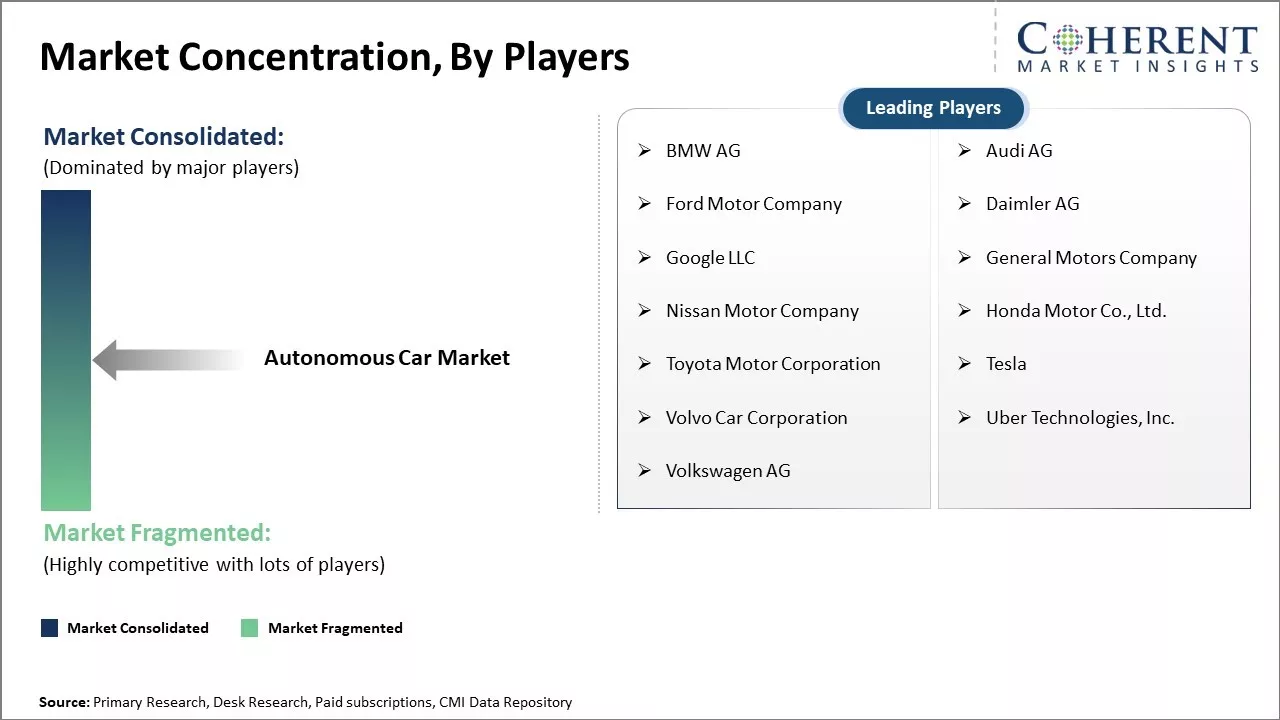
Get actionable strategies to beat competition: Request sample copy
Increased Mobility and AccessibilityAnother major factor that is driving interest and investment in autonomous cars is the ability of this technology to increase mobility and accessibility for all. Autonomous vehicles can help the elderly, disabled and unlicensed populations such as children to gain independent transport when these people are unable to drive conventional cars themselves. Removing the requirement for a licensed driver to operate a vehicle can eliminate a major obstacle that currently restricts personal mobility for these groups. This enhanced mobility could improve their quality of life tremendously by facilitating greater access to essential services, healthcare, education and employment opportunities.
Autonomous vehicles also give people the opportunity to use their travel time efficiently instead of concentrating solely on driving. This is based on findings from several surveys, Americans on an average spend over 50 minutes daily commuting, time which could be better spent working, relaxing or attending to other needs/priorities from within the vehicle. This increased accessibility and freedom that autonomous driving enables could massively boost overall productivity at both personal and societal levels.
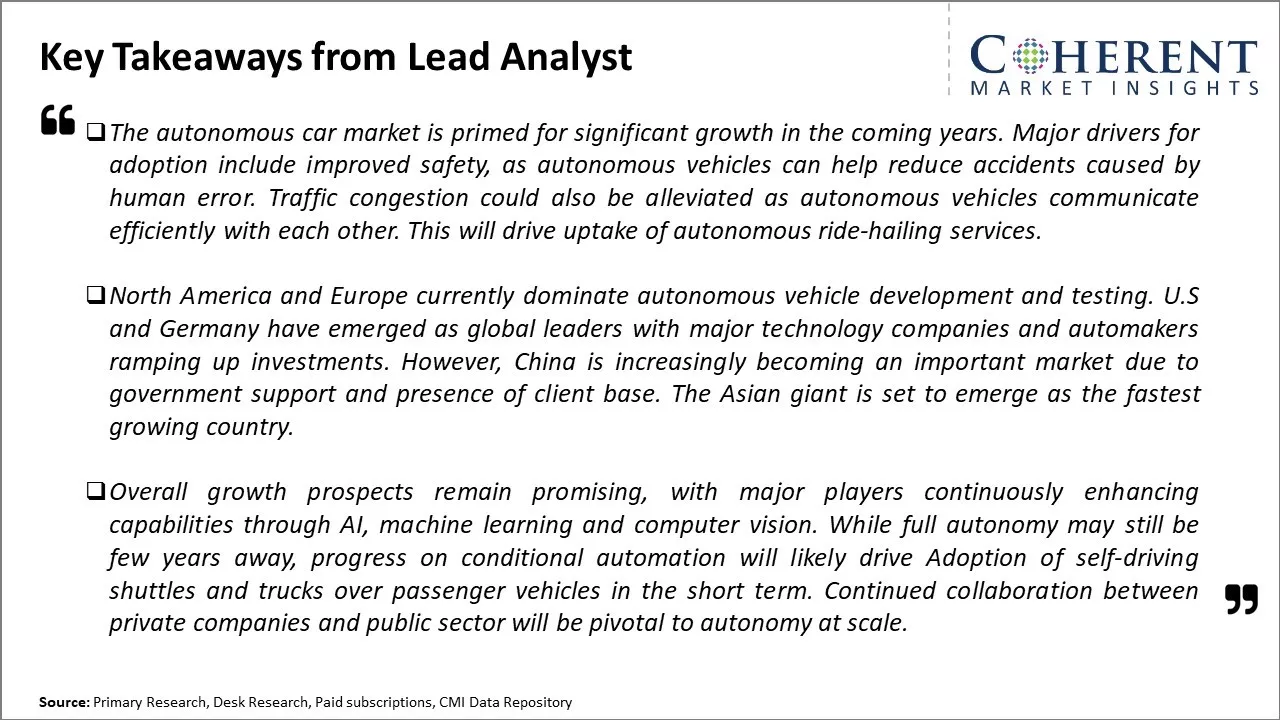
To learn more about this report, Request sample copy
Market Challenges: Cyber Security Threats and Hacking RisksThere are several technological challenges currently inhibiting the mass adoption of autonomous vehicles. Sensors need to become more accurate at interpreting situations like construction zones and emergency vehicles. Software must be able to handle any road conditions and anticipate unexpected movements of pedestrians, cyclists and other vehicles. High definition maps still need improvements to provide fully driverless capabilities in new areas. Public perception of safety remains an obstacle as well, as does the issue of high development costs which has made autonomous technologies available only in premium models so far.
Market Opportunities: Reduction in accidents and associated insurance cost
However, the potential for growth in this industry is enormous. As the technology becomes more advanced and the costs decrease due to maturing sensors and software, there will be opportunities to expand into mainstream brands and models. Ride-sharing networks and delivery fleets are potential early adopters. For many, particularly the elderly and disabled, autonomy opens the door to independent transportation. Automakers see a future of mobility services as a new revenue stream.
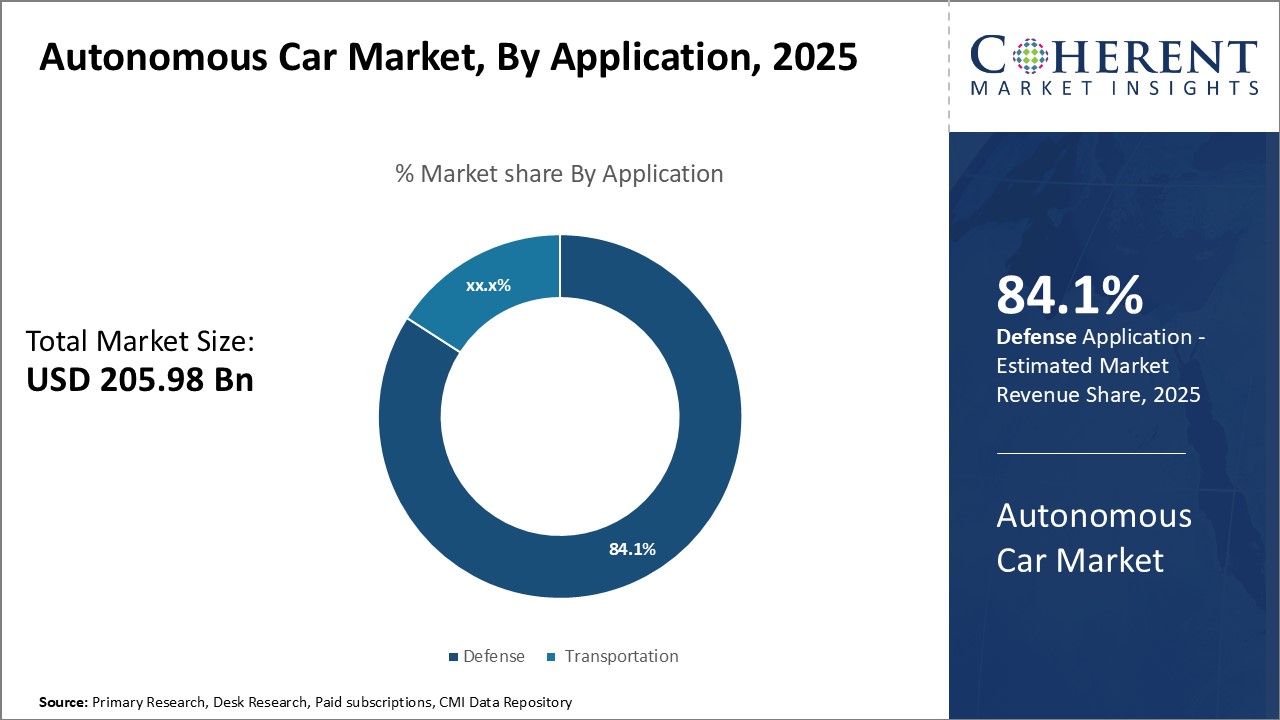
Discover high revenue pocket segments and roadmap to it: Request sample copy
Insights, By Application- Convenience and Safety Drives Transportation Segment GrowthWithin the application segment of the autonomous car market, transportation segment accounts for the largest share of 84.1% in 2025 due to the convenience and safety autonomous features it provides. As traffic congestion continues to worsen in many urban areas around the world, autonomous vehicles offer a solution that saves commuters time and reduces stress. Being able to work, rest, or be entertained while the car drives itself makes long commute times more productive. Autonomous transportation also appeals to those who do not drive or are unable to, such as the elderly, disabled, or young people. Having independent mobility options improves quality of life and access to services.
Safety is another major advantage of autonomous transportation. Nearly 94% of traffic accidents are caused by human error, from factors like distracted driving, driving under the influence, or fatigue. Autonomous vehicles utilize sensor fusion and artificial intelligence to navigate roads safely without these human risks. These can detect hazards, apply brakes faster than humans, and make optimal driving decisions to avoid accidents. This is particularly valuable for reducing accidents, injuries and fatalities from human carelessness or lack of ability. The potential to dramatically cut traffic deaths alone justifies significant investment and adoption of autonomous transportation technologies.
Insights, By Level of Automation- Increased Automation Promotes Growth in Level 3 Systems
Within the level of automation segment, Level 3 has been widely adopted because it offers a good balance between functionality and safety features and estimated to be the leading segment with 47.8% market share in 2025. Level 3 systems can drive autonomously under limited conditions but still require a human driver to be responsive to take control if needed. This hybrid approach appeals to both automakers and consumers as it incrementally increases autonomous ability while maintaining human oversight for assurance. Level 3 vehicles use advanced driver assistance features for highway driving, but Autonomous driving system still require human monitoring and keep the steering wheel for handling complex situations.
Major automakers have prioritized developing level 3 systems as the next step in the progression towards full autonomy. These aim to introduce highly automated highway driving within the next five years that takes over all critical functions but keeps the driver available as a fallback in uncertain situations. Consumers also favor level 3 technologies as an affordable way to gain benefits of autonomous driving without requiring complete reliance on AI systems. Increasing capabilities of level 3 promote its highest share of the current autonomous car market until truly driverless cars at levels 4 and 5 can operate without human intervention in all conditions.
Insights, By Propulsion Type- Adaptability Boosts Semi-Autonomous Segment Share
In the propulsion type segment, semi-autonomous segment account for the largest proportion of 74% market share in 2025 owing to their wider adaptability compared to fully autonomous alternatives. While fully autonomous vehicles only operate independently without human involvement, semi-autonomous cars maintain the flexibility for both computerized driving and traditional manual operation by a human driver. These seamlessly blend self-driving modes with conventional driving through features like adaptive cruise control, lane keeping assist, automated emergency braking and parking capabilities.
This hybrid model appeals greatly to automakers seeking a smooth transition path to advance driver assistance technologies. It allows incremental upgrades to autonomous systems within existing vehicle platforms without disruptive changes. For consumers, semi-autonomous vehicles provide partial self-driving convenience when desired but retain full manual driving control based on user preference or route complexity. Their versatility for both autonomous and standard driving boosts wider acceptance, lower development costs and easier integration into current road infrastructure than purely autonomous options dependent on full infrastructure and technology readiness. As semi-autonomous propulsion remains the most adaptable to gradual change, it naturally commands the highest market share in today's developing autonomous landscape.
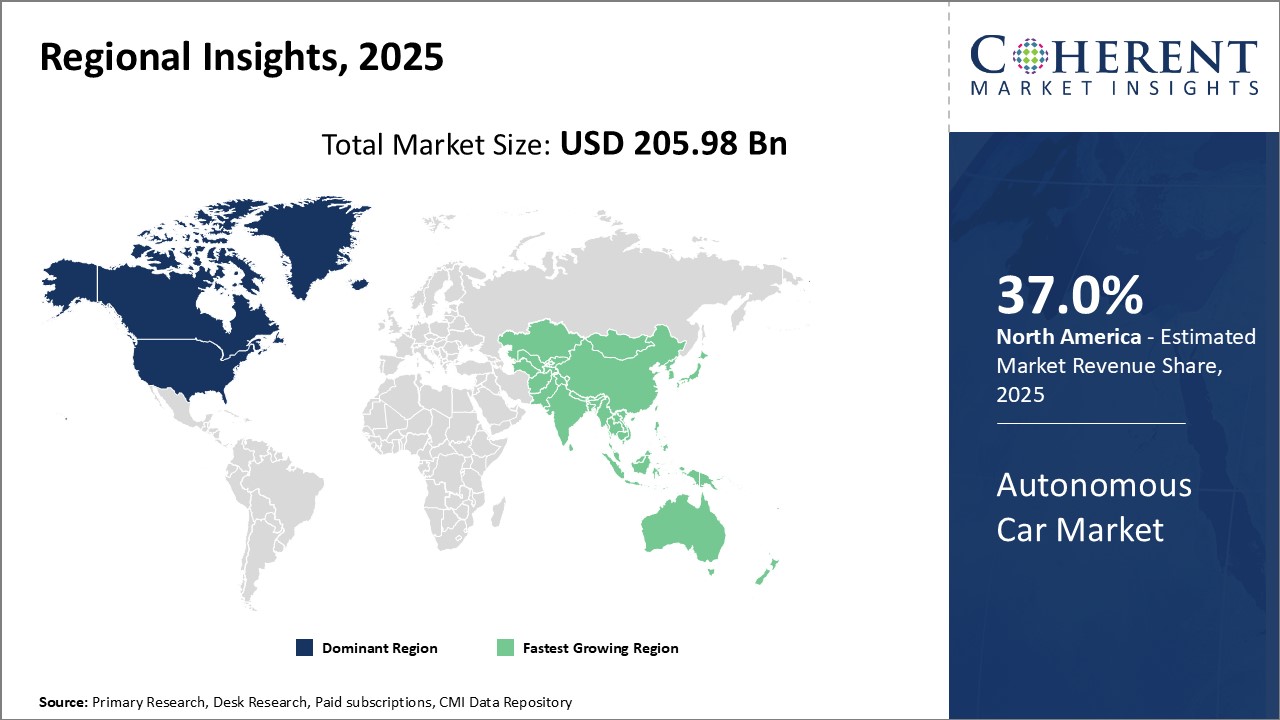
Need a Different Region or Segment? Customize now
North America dominated the autonomous car market with 37.0% market share in 2025. The U.S. accounts for the largest share, supported by significant investments from technology giants like Google, Tesla, GM and Ford into research and development of self-driving cars. Government policies are also autonomous vehicle friendly, with many states allowing on-road testing. Moreover, American consumers have shown early acceptance of advanced driver-assistance systems, boding well for future autonomous car adoption. With its large automotive industry and wealthy consumer base, North America is set to remain the revenue leader.
However, China is emerging as the fastest growing regional market. The size of the Chinese auto industry and buyer demand makes it extremely lucrative for automakers and tech companies to push autonomous vehicle development. Chinese government has proactively implemented policies to transform the country into a global hub for autonomous mobility technologies. It has designated several cities for large-scale pilot programs and testing of autonomous vehicles. Major investments are underway to develop supporting infrastructure as well. Chinese brands are ramping up investments while international JVs are expanding local research centers, underscoring the industry's confidence in China's potential
These analyses point toward North America and China as the key regional markets currently and in the foreseeable future. While North America enjoys early dominance backed by industry leadership and public supportiveness, China is rapidly ascending due to strong government endorsement which is effectively channeling resources and scaling projects. Both markets are strategically important given their size and influence on the global autonomous car market trajectory.
Autonomous Car Market Report Coverage
| Report Coverage | Details | ||
|---|---|---|---|
| Base Year: | 2024 | Market Size in 2025: | USD 205.98 Bn |
| Historical Data for: | 2020 To 2024 | Forecast Period: | 2025 To 2032 |
| Forecast Period 2025 to 2032 CAGR: | 40.3% | 2032 Value Projection: | USD 2,205.13 Bn |
| Geographies covered: |
|
||
| Segments covered: |
|
||
| Companies covered: |
BMW AG, Audi AG, Ford Motor Company, Daimler AG, Google LLC, General Motors Company, Nissan Motor Company, Honda Motor Co., Ltd., Toyota Motor Corporation, Tesla, Volvo Car Corporation, Uber Technologies, Inc., Volkswagen AG |
||
| Growth Drivers: |
|
||
| Restraints & Challenges: |
|
||
Uncover macros and micros vetted on 75+ parameters: Get instant access to report
*Definition:The autonomous car market involves the development and sales of self-driving vehicles that can provide transportation without human involvement. Major players in this emerging market are developing advanced sensors and robotics to enable vehicles to navigate roads and make decisions without any human input. As the technology progresses to higher levels of autonomy over the next decade, the market for fully autonomous vehicles without steering wheels or pedals is expected to grow substantially and potentially transform personal transportation.
Share
Share
About Author
Ameya Thakkar is a seasoned management consultant with 9+ years of experience optimizing operations and driving growth for companies in the automotive and transportation sector. As a senior consultant at CMI, Ameya has led strategic initiatives that have delivered over $50M in cost savings and revenue gains for clients. Ameya specializes in supply chain optimization, process re-engineering, and identification of deep revenue pockets. He has deep expertise in the automotive industry, having worked with major OEMs and suppliers on complex challenges such as supplier analysis, demand analysis, competitive analysis, and Industry 4.0 implementation.
Missing comfort of reading report in your local language? Find your preferred language :
Transform your Strategy with Exclusive Trending Reports :
Frequently Asked Questions
Joining thousands of companies around the world committed to making the Excellent Business Solutions.
View All Our Clients
US Reciprocal Tax Impact Analysis On Autonomous Car Market
Stay updated on tariff changes with expert insights and timely information